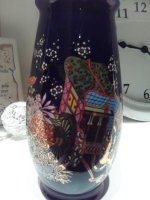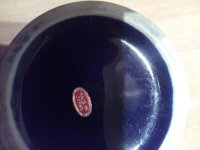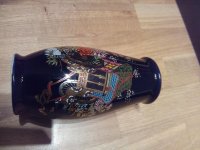You are using an out of date browser. It may not display this or other websites correctly.
You should upgrade or use an alternative browser.
You should upgrade or use an alternative browser.
how old is this vase
- Thread starter greenred
- Start date
I found this one it´s similar:
http://www.ebay.com/itm/Cobalt-Blue...4e715b4&pid=100005&rk=1&rkt=6&sd=152395207573
http://www.ebay.com/itm/Cobalt-Blue...4e715b4&pid=100005&rk=1&rkt=6&sd=152395207573
Bayoutalker
Elite Member
Made in Japan labels seem to begin after 1915 and were used until after WWII when Made in Occupied Japan was used (1947).
Cliff
Cliff
Rudy
Admin
Hi I´m wondering about this vase we have
my mother in law says that it´s about 100year old
but I´m wondering why then is this glueslip on the bottom of it marked "made in japan"
It's a pretty vase, but with that sticker... it is not 100 years old.
Early Japanese ceramics were scribed, in Japanese, by the artist or manufacturer. Later, they were designated as coming from Nippon. The U.S. Customs Bureau ruled that "Nippon" was no longer an acceptable synonym and as of August 1, 1921 all goods were supposed to be backstamped "Japan". Technically, the Made in Japan Era began when NIppon era ended in 1921, but it really was not that precise. At some point the U>S> Customs Bureau may have required that the words," MADE IN" be added to the backstamps, but this was not always done. Unmarked pieces sometimes slipped through Customs ,but most of the ceramics from 1921 to 1941 are marked either "JAPAN" or "MADE IN JAPAN" .
During WWII, no Japanese ceramics were imported to the US. After the war, during the 1947-1952 period, they were marked with a sticker that said OCCUPIED JAPAN or MADE IN OCCUPIED JAPAN.
When the Occupation ended in 1952, marks no longer contained the work "Occupied" so pieces were again marked only with "Japan" or "Made in Japan". This is when the paper label era really began. Prior to WWII, paper labels were flimsy and the glue was often not strong, so the Customs Bureau usually made importers replace the labels with indelible ink backstamps. In the 1950's, technology improved and paper labels were allowed. The two most common types of labels are Small oval or rectangular blue or black paper with white letters; Two -color metallic, such as black or red with gold or silver lettering.
I would say from the look of the sticker, and the artwork motiff that it is probably from the '60s or later.
You can find more infor here: http://ezinearticles.com/?A-Short-H...gs-and-Dating-of-Japanese-Ceramics&id=6669336
Bayoutalker
Elite Member
"In 1914 the Tariff Act has amended to make the words "Made In" in addition to the country of origin mandatory. This was not rigorously enforced until around 1921 so some pre 1921 pieces can still be found without the "Made In" wordage."It's a pretty vase, but with that sticker... it is not 100 years old.
Early Japanese ceramics were scribed, in Japanese, by the artist or manufacturer. Later, they were designated as coming from Nippon. The U.S. Customs Bureau ruled that "Nippon" was no longer an acceptable synonym and as of August 1, 1921 all goods were supposed to be backstamped "Japan". Technically, the Made in Japan Era began when NIppon era ended in 1921, but it really was not that precise. At some point the U>S> Customs Bureau may have required that the words," MADE IN" be added to the backstamps, but this was not always done. Unmarked pieces sometimes slipped through Customs ,but most of the ceramics from 1921 to 1941 are marked either "JAPAN" or "MADE IN JAPAN" .
During WWII, no Japanese ceramics were imported to the US. After the war, during the 1947-1952 period, they were marked with a sticker that said OCCUPIED JAPAN or MADE IN OCCUPIED JAPAN.
When the Occupation ended in 1952, marks no longer contained the work "Occupied" so pieces were again marked only with "Japan" or "Made in Japan". This is when the paper label era really began. Prior to WWII, paper labels were flimsy and the glue was often not strong, so the Customs Bureau usually made importers replace the labels with indelible ink backstamps. In the 1950's, technology improved and paper labels were allowed. The two most common types of labels are Small oval or rectangular blue or black paper with white letters; Two -color metallic, such as black or red with gold or silver lettering.
I would say from the look of the sticker, and the artwork motiff that it is probably from the '60s or later.
You can find more infor here: http://ezinearticles.com/?A-Short-H...gs-and-Dating-of-Japanese-Ceramics&id=6669336
This statement is from the article listed so it is possibly from 1914-15 but that would only be about 100 years now. How long ago were you told it was that old?
Cliff
Rudy
Admin
"In 1914 the Tariff Act has amended to make the words "Made In" in addition to the country of origin mandatory. This was not rigorously enforced until around 1921 so some pre 1921 pieces can still be found without the "Made In" wordage."
This statement is from the article listed so it is possibly from 1914-15 but that would only be about 100 years now. How long ago were you told it was that old?
Cliff
Metallic foil stickers came much later than 1914-1915.
GLASSHOPPER1955
Elite Member
That sticker screams 1950s to 1960s. When Japanese imports flooded America.
Similar threads
- Replies
- 2
- Views
- 79




